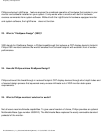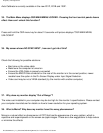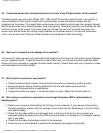Frequently Asked Questions
of years, the monitor's brightness deteriorates to below 50% of its original value. At this stage, the usable
life of a monitor is considered ended. Auto Calibrate regularly readjusts color temperature and luminance
to their original values.
31. How does Philips Auto Calibrate feature benefit me?
With Auto Calibrate, it takes a monitor's luminance 33 percent longer to deteriorate to the 50 percent level
that marks the end of a display device's useful life. Thanks to Auto Calibrate, a monitor with a normal life
of 10,000 hours, for example, would last for 13,300 hours, a full one third longer.
32. How does Auto Calibrate work?
During the calibration process, different predefined black and white images are displayed on thescreen.
The beam currents of the red, green and blue cannon are accurately measured and compared to the
original values stored in the monitor. By readjusting gain values of the individual cannons, deviation is
reduced to zero. Default values are stored during production. If the user sets a new color temperature, this
new value is saved as the new default value.
33. When should calibration be performed?
The calibration process takes less than six seconds. During this period, different specific images are
displayed. After the process is finalized, the original image is redisplayed. Constant re-calibration is not
required. Calibration should be performed after the monitor is warmed up. Auto Calibration takes place
when a monitor receives a signal indicating an imminent switch to its sleep mode/stand-by mode.
34. Which models of Philips monitors are equipped with Auto Calibrate feature?
file:///D|/EDFU/crt_17_5/edoc/ENGLISH/FAQ.HTM (9 of 14)7/15/2004 3:43:28 PM


















